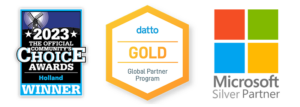Each year, Webroot® analyzes threat activity to discover new trends across malware, phishing, cryptojacking, and more in their annual Webroot® Threat Report.
Notable findings from the 2020 Webroot® Threat Report include:
- Phishing URLs increased by 640%
- 1 in 4 malicious URLs is hosted on an otherwise benign site
- 8.9 million URLs were found hosting a cryptojacking script
- New industries are reporting higher-than-average infection rates
- In 2019, 93.6% of malware detected was only seen on a single PC. This is the highest yearly rate ever seen, although the number has been above 90% since 2014
- Consumer devices remain approx. 2x more likely to become infected than business systems
- Malware targeting Windows 7 increased by 125%
- 85% of malware threats hide in 1 of 4 locations: %temp%, %appdata%, %cache% and %windir%
- When it comes to Ransomware, the average ransom amount is increasing. In Q3 2019, it reached $41,198, up from $36,295 in Q1
- 2019 saw an epidemic of ransomware attacks on US cities, as well as systematic attacks on favored targets, such as transportation, healthcare, education, and SMBs
- A recent trend in ransomware is to not just steal or lock an organization’s data, but to threaten the victim with leaking or otherwise abusing the data. This increases the likelihood that victims will still pay
- There are over 26 million IP address-related security incidents each day
- IP addresses associated with Windows exploits grew by 360%
- Running 11 or more security awareness training courses over 4-6 months reduces phishing click-through by
Download the full 2020 Webroot® Threat Report to become more resilient in the face of new and existing threats.

President / Network Architect
Mark Kolean always had a fascination with technology from the time he was 3 and his gift of the Atari 2600 to current. In 1990 at the age of 14 Mark got his first job in customer support for a mail order business supporting Tandy TSR-80 computer software shipped on cassette tape. A few years later Mark was building hundreds of 286, 386, and 486 computers for the new emerging DOS & Windows 3.1 computers that had exploded on the market.
After a college career studying business and technology Mark Started Shoreline Computer Systems in 1999 at the height of the dot.com boom with the looming crisis of the year2k bug just around the corner. In the early 2000’s a lot of work was done with early network systems including Lantastic, Novell, and Windows NT Server. Mark became a community contributor to the Small Business Specialist community that revolved around Small Business Server 2000-2011 which focused on single or dual server environments for businesses up to 50 in size. Networks during this time frame mostly had a break fix relationship in which work was billed only when a problem occurred.
In the 2010’s Microsoft released their first cloud based software called Microsoft BPOS which would in later become known as Microsoft Office 365. This introduced a new model in technology with pay as you go subscription services. Starting in 2013 Mark’s team at Shoreline Computer System rebranded as Shoreline Technology Solutions to focus on the transition to become proactive and less reactive to data backup and security needs. Starting in 2018 all customers are required to have a backup management plan in place as a center point with the full understanding that if STS isn’t watching the customer’s data, then no one is.
Now in Mark’s 22 years of business he is building a company emphasis of how to help customers retire servers and build networks completely in the cloud.


Leave a Reply
You must be logged in to post a comment.